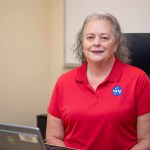Rae Anderson never intended to pursue a career at NASA, but pursuing opportunities around her interest in computer science led the Union City, Tennessee native to an agency that explores the secrets of space for the benefit of all.
On the other hand, Anderson’s desire to expand her knowledge helped her become the first employee at NASA’s Stennis Space Center—and one of only five civil servants at NASA—to earn the highest honor in the Program of Technical Excellence for Mission Safety and Assurance in the discipline of Software Assurance. .
“I want to be good at my job, so I made it a goal early in my career to get this certification,” Anderson said.
The program’s level four certification demonstrates Anderson’s commitment to developing her knowledge and skills to become an effective contributor to the agency’s mission. As a software assurance subject matter expert, Anderson serves as the technical lead for a team in the NASA Stennis Mission Safety and Assurance Directorate that supports the center’s work with propulsion and autonomous systems testing.

rae anderson
NASA Stennis SME for Software Assurance
Whether it’s testing propulsion for NASA’s Artemis mission or autonomous systems working on the first autonomous systems-in-flight mission, work at NASA Stennis relies on software to accomplish complex tasks. Anderson’s team reviews software management plans to ensure that all requirements are met to perform the job safely. It helps guide efforts to identify potential hazards and, if they exist, to implement controls and mitigation measures to reduce risk.
“It’s important to make sure any potential problems are mitigated,” Anderson said. “It’s not a guarantee, but it gives a better sense that everyone did what they were supposed to do in terms of tracking the process and that the software is technically sound to move forward. There will always be bugs with software because there are so many of them. We are there as engineering checks and balances as the project progresses.”
Before she went ahead and earned a computer science degree at the University of Tennessee-Martin, Anderson grew up 20 minutes from the Tennessee-Kentucky border, which meant she didn’t live near a NASA center. When she thought about NASA and space, astronauts and the solar system came to mind.
Since Anderson’s career in software brought her to Slidell, Louisiana, and finally started working at NASA Stennis 16 years ago, Anderson has discovered that NASA is much more. She found NASA to be a place that combined her knowledge of software with a diverse and highly skilled workforce, coming together for the benefit of humanity.
“Along the way, I’ve been part of a team at NASA Stennis that has good people who will do what they need to do to achieve the goals, whatever it takes to get there and to do it safely,” Anderson said.
For information about NASA’s Stennis Space Center, visit:
Stennis Space Center – NASA